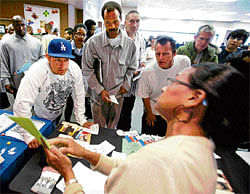Many US cities face a long wait for jobs to return

In some regions, those years are in danger of turning into a decade. According to a report to be released soon, nearly 50 metropolitan regions, or more than one out of seven, are unlikely to bring back all the jobs lost in the recession until after 2020.
Among those areas are Cleveland and Dayton, Ohio; Detroit, Michigan; Reno, Nevada; and Atlantic City, New Jersey, according to the report commissioned by the US Conference of Mayors.
Detroit, which lost 3,23,400 jobs during the recession, and Reno, which lost 36,000 jobs, are not expected to regain all of those positions until after 2021. With job creation having slowed to a crawl and the housing market depressed by foreclosures and falling prices, the economy is struggling to put 13.9 million unemployed Americans back to work.
According to the mayors’ report, which was compiled by IHS Global Insight, the nation’s 363 metropolitan statistical areas tracked by the Labour Department will generate enough jobs to get back to only the prerecession peak of employment in the first half of 2014, a dreary forecast that poses an increasing political challenge to the Obama administration. The areas lost 7.3 million total jobs during the recession from a peak of 118.3 million in the first quarter of 2008.
The report notes that metro regions account for about 86 per cent of all jobs. “It is striking, it’s sobering and it’s a call to action,” said Los Angeles mayor Antonio R Villaraigosa, who is also the president of the Conference of Mayors. Villaraigosa suggested that the federal government invest in infrastructure as well as workforce training. The mayors’ report projected that the Los Angeles region, which lost 5,37,100 jobs during the downturn, would not gain them back before 2018.
The forecasts do not account for the number of jobs that need to be created just to account for normal population growth. As a result, said IHS Global Insight senior director James Diffley, even when the economy adds back the jobs lost during the recession, the unemployment rate, now at 9.1 per cent, is likely to be significantly higher than the 4.4 per cent it was before the crisis.
Among the largest metropolitan regions that will have a long road to recovery are manufacturing centers in Ohio and Michigan, where huge waves of layoffs at car plants and other factories affected thousands of workers.
“The type of jobs lost are not easily replaced,” said Lucious Plant, workforce development manager in Montgomery County, which includes Dayton and surrounding communities. The region was overwhelmed by thousands of job losses at plants operated by General Motors and the parts suppliers, Delphi Automotive.
Plant said old-line factory workers did not necessarily have the skills for the jobs that are now being added by advanced manufacturers. Dayton, which lost 42,500 jobs, or more than 10 per cent of its labour force, during the recession, has had some luck attracting new employers recently, landing a Caterpillar Logistics distribution center that is expected to eventually bring on 600 people. Also, the back-office operations of a law firm added about 200 jobs.
Since losing a job at Delphi in 2008, Josh Hamer has been taking odd jobs repairing computers and is attending community college on government grants to earn an associate’s degree in network management. In the meantime, he has filed hundreds of job applications.
“I want anything that will pay the bills,” Hamer said. “But they see Delphi and they see me applying for an office job, and they say, ‘You can’t do this job because you’re not qualified for it.’ They see grunt work, and they see a grunt.”
Other regions were hammered by the housing collapse and are having difficulty climbing back. In Naples, Florida, which lost 25,200 jobs during the recession, local economic development officials are focusing on small businesses in the technology and medical device sectors, industries that may not help unemployed construction workers. The mayors’ report projects that the area will get back to its prerecession peak by 2017.
Tammie Nemecek, chief executive of the Economic Development Council of Collier County, Folrida, said the region might not recapture all the jobs it lost. “There’s a lot of people saying I want a new economy so we can ensure that there’s sustainability in it,” she said.
The mayors’ report does project faster recovery in some regions, including several metropolitan areas in Texas, as well as Denver, Colorado; Raleigh, North Carolina and Washington. Global Insight forecasts that the New York metropolitan region, which lost 3,85,200 jobs during the recession, will get back to its prerecession peak by 2013, in part because the financial sector did not lose as many jobs as feared.
That could change as Wall Street, facing falling markets and an uncertain regulatory climate, plans further cuts to its work force. Some metropolitan regions disputed the forecasts. In Cleveland, where Global Insight projects a return to peak employment in 2021, Mayor Frank G Jackson’s chief of staff, Ken Silliman, said Cleveland’s unemployment rate, 7.6 per cent, was the seventh lowest of the metropolitan areas with more than 1.5 million people.
He added that a newly built medical center was “staking out Cleveland as a national leader in medical technology” and that the area would recapture the jobs it lost within three to five years “without a doubt”.
Diffley of Global Insight said that many regions were trying to brand themselves as leaders in new sectors. “It’s not a zero sum game,” Diffley said. “But everybody can’t be a leader in the field they’d like to be, by definition.”
Deccan Herald is on WhatsApp Channels| Join now for Breaking News & Editor's Picks